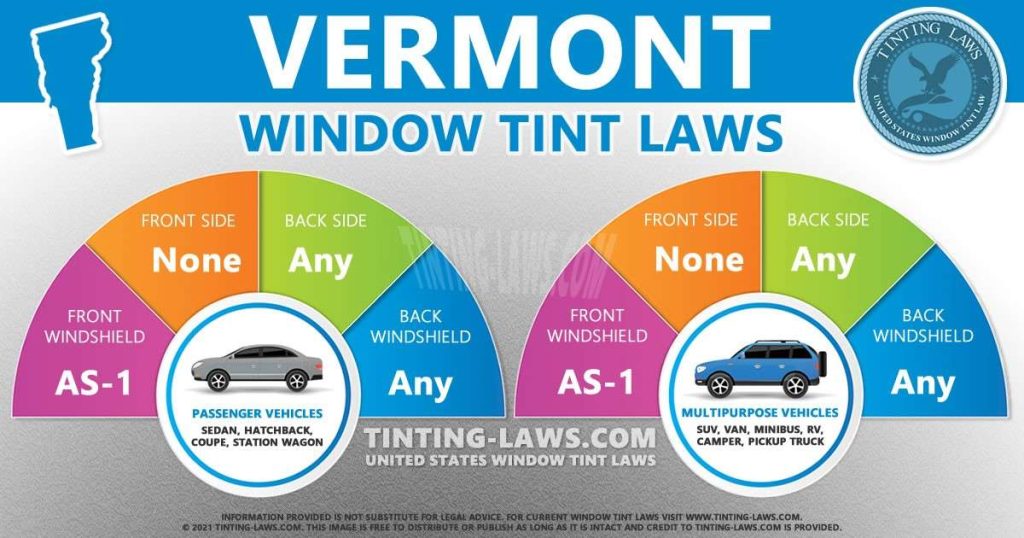Vermont Window Tinting Laws
Car window tinting laws in Vermont were enacted in 1984.
We have provided all the necessary information about your car’s window tint, including how dark or reflective the tint is allowed in your state.
There are also additional car window tinting rules and regulations in Vermont so make sure you read all about it below.
Window tint darkness in Vermont
The percent of visible light allowed through your car windows is called VLT: Visible Light Transmission.
The percentage of light allowed through your film and glass in Vermont is very specific and different for sedan cars and SUV cars or vans.
Tint darkness for sedans:
- Windshield: Non-reflective tint is allowed above the manufacturer’s AS-1 line.
- Front Side windows: No tint can be applied legally to this window.
- Back Side windows: Any darkness can be used.
- Rear Window: Any darkness can be used.
Tint darkness for SUV and vans:
- Windshield: Non-reflective tint is allowed above the manufacturer’s AS-1 line.
- Front Side windows: No tint can be applied legally to this window.
- Back Side windows: Any darkness can be used.
- Rear Window: Any darkness can be used.
Window tint reflection in Vermont
Window tint can reflect incoming light and reduce glare and heat.
Vermont window tint law permits a certain window reflection when using a tint so make sure you pay attention to this as well.
Tint reflection for sedans:
- Front Side windows: No mirrored or metallic appearance.
- Back Side windows: No mirrored or metallic appearance.
Tint reflection for SUV and vans:
- Front Side windows: No mirrored or metallic appearance.
- Back Side windows: No mirrored or metallic appearance.
Other Vermont window tint rules and regulations:
Vermont does have several other important laws, rules and regulations pertaining to window tinting. They include the following:
- Side Mirrors: Dual side mirrors are required in this state if back window is tinted.
- Restricted Colors: Vermont does not prohibit usage of any tint colors.
- Certificates: Film manufacturers don’t need to certify the film.
- Stickers: No sticker to identify legal tinting is required by law.
- Medical Exceptions: Vermont tinting law permits medical exemptions and allows the use of darker tint.
Keep in mind that Vermont tinting laws and regulations may be interpreted differently in your county or place of residence.
We always recommend double-checking our information with your local DMV or law enforcement authorities.

Our information about window tint laws in Vermont was last updated in 2024.
Tinting laws in Vermont were enacted in 1984.
In case any of our info provided is not up to date or correct be sure to contact us so we can fix it. Thanks!
Trusted industry leader in providing accurate window tint laws. Share with confidence:
State of Vermont Info
Vermont (VT) is a state in the New England region of the northeastern United States.
Vermont is the 6th least extensive and the 2nd least populous of the 50 United States.

The state of Vermont is the leading producer of maple syrup in the United States.
The state capital is Montpelier, which has a population of 7,855 and is the least populous state capital in the country.
Vermont’s most populous city is Burlington, with a 2010 population of 42,417.
Capital: Montpelier
Population: 645,570
Area: 9,620 sq mi (24,923 km2)
Cities in Vermont: Burlington, Montpelier, Brattleboro, Stowe, South Burlington, Bennington, Killington, Middlebury, Manchester, Woodstock, Waterbury, Rutland City, Colchester, Essex Junction, St. Johnsbury, Williston, Shelburne, Winooski, Quechee, Adamant, Vergennes, Marlboro, Barre City, Bellows Falls, Waitsfield, St. Albans, Essex, Stratton, Springfield, Ludlow, Jericho, Morrisville, Newport, Thetford, Norwich, Wilmington, Shaftsbury, Windsor, Putney, Chester, Warren, Lyndonville, Northfield, Craftsbury, Milton, Dorset, Hartford, Hinesburg, Castleton, Rutland
Counties in Vermont: Addison, Bennington, Caledonia, Chittenden, Essex, Franklin, Grand Isle, Lamoille, Orange, Orleans, Rutland, Washington, Windham, Windsor
Tint law references:
Vermont Statutes Title 23, Chapter 13, Subchapter 1, section 1125: Obstructing windshields
Medical exemption info:
Vermont DMV – Application for window tint medical exemption permit (.pdf file)